Table of Contents
Context: In India consumption is subdued and private investment is weak. But exports could offer a way out.
More in News
- India’s GDP is roughly $4 trillion while global GDP is a little more than $100 trillion.
- That means that India’s share of the global economy is around 4%.
- But its share in global goods exports is much smaller, less than 2%.
Background of Slowdown in the Indian Economy
- Decline in GDP Growth Rate:
- India’s GDP growth has consistently declined in recent quarters, from over 8% in mid-2023 to less than 5.5% in September 2024.
- High-frequency indicators confirm a slowdown, reflecting weaker economic momentum beyond statistical anomalies.
- Subdued Consumption Demand:
- Urban consumption remains weak, dampening overall demand.
- This slowdown impacts private investment, as industries face excess capacity utilization and hesitate to expand.
- Weak Private Investment:
- Despite healthy corporate balance sheets, private investment remains short.
- Lack of demand for additional production capacity discourages new investments.
- Fiscal Constraints on Public Investment:
- Government spending has been a key driver of growth, but fiscal limits are nearing, restricting further expansion.
- Persistent reliance on government-led demand is unsustainable.
- Declining Foreign Direct Investment (FDI):
- FDI inflows stagnated at $66 billion in 2023-24, with only a small proportion directed toward manufacturing.
- Missed opportunities to capitalize on global supply chain shifts from China.
Why Export is a Way Out
- Potential Growth Through Exports
- A targeted increase in export share by 1 percentage point over five years could add 1% to annual GDP growth.
- A 50% increase in export volumes implies substantial economic benefits and job creation.
- Global Dynamics Favoring India
- Multinational corporations are shifting supply chains away from China, creating an opening for India.
- India’s demographic advantages and policy measures like the PLI scheme make it a strong contender for FDI.
- Manufacturing as a Catalyst
- Attracting FDI in manufacturing could increase India’s competitiveness in global markets.
- Export-oriented manufacturing has historically driven growth across Asia.
Policy Recommendations for Export-Led Growth
- Consistent Trade Policy:
- Minimize tariff changes and avoid import/export bans.
- Shift from protectionist policies to a free-trade mindset.
- Improved Exchange Rate Management: Allow exchange rates to reflect market dynamics to enhance export competitiveness.
- Enhanced Ease of Doing Business: Simplify regulatory frameworks to attract foreign and domestic investment.
- Boost FDI in Manufacturing:
- Expand and streamline schemes like PLI.
- Ensure infrastructure and skill development to support manufacturing growth.
- Transparent and Predictable Policies: Avoid policy flip-flops to instill confidence in investors and businesses.
- Level Playing Field: Equal opportunities for domestic and foreign firms to foster healthy competition.


 PAC Report on GST Reforms and Recommenda...
PAC Report on GST Reforms and Recommenda...
 Regional Rural Banks in India, Objective...
Regional Rural Banks in India, Objective...
 Micro, Small and Medium Enterprises (MSM...
Micro, Small and Medium Enterprises (MSM...





















